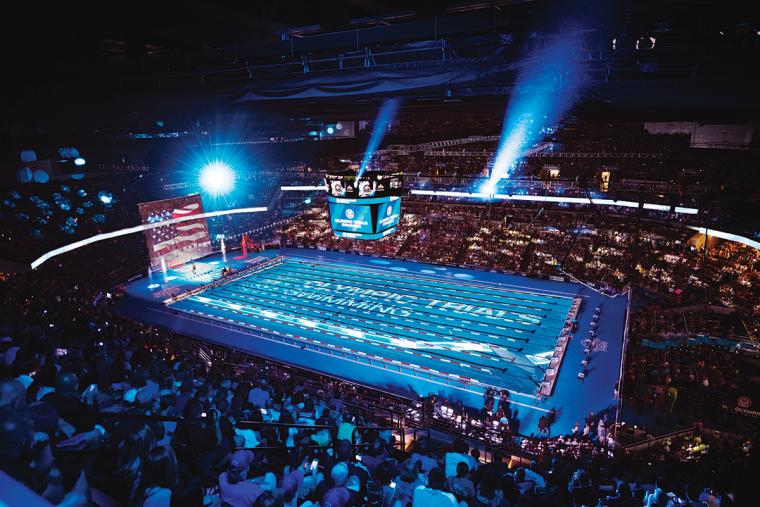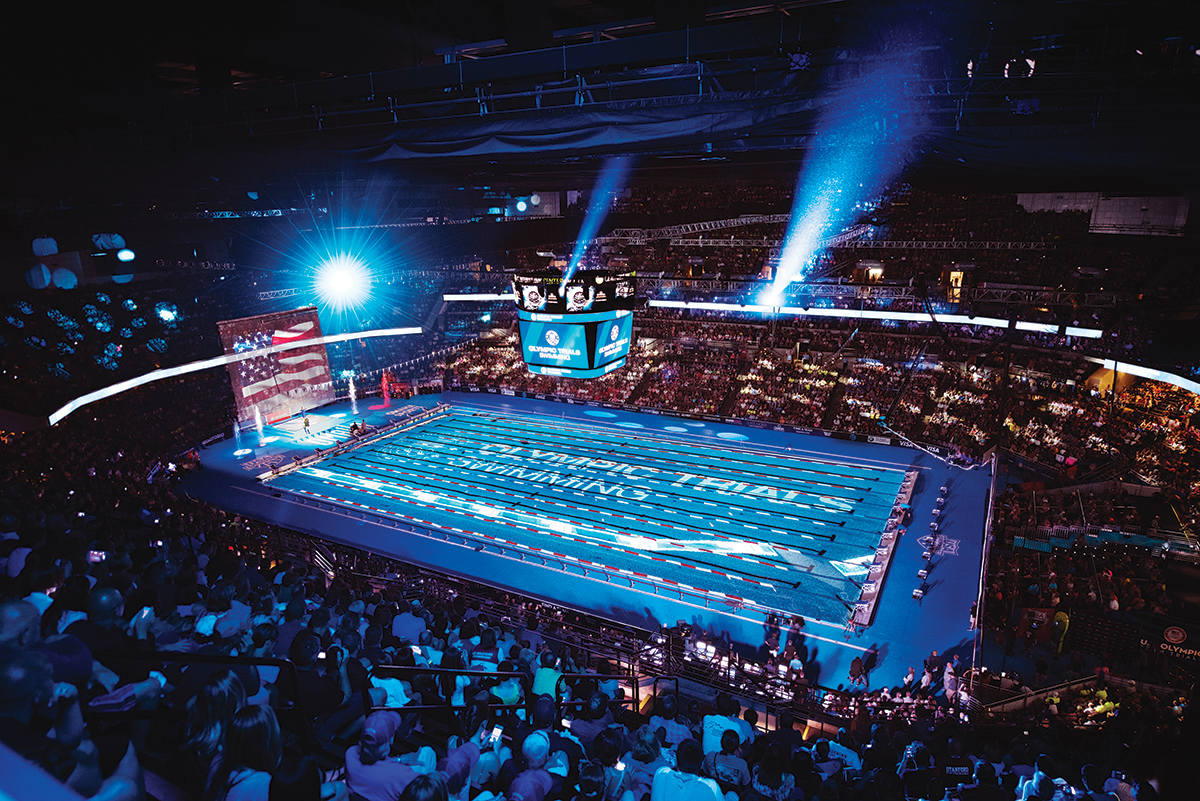Aquatics Venues Are Key to Cities’ Rebound


“This is Omaha’s Super Bowl,” says Josh Todd, president and executive director of the commission. “We’re so happy the event has stayed here, and it’s going to be a nice little shot in the arm after all of the events that were lost because of the pandemic.”
Coronavirus forced the one-year delay of the 2020 Summer Olympics in Tokyo and brought to a screeching halt Omaha’s plans to host the trials last June. At that point, the challenge became finding a way to reschedule an epic event that takes over the CHI Health Center for five weeks and is typically booked at least three years in advance. Thanks to the commission’s longstanding relationship with USA Swimming, arena and convention officials, and other partners, a new plan came together within months.
“Being able to move things around and make room for such a huge event while not interrupting all the normal business in Omaha took time, but it happened pretty quickly,” Todd says. “By the fall of 2020, we were committed to having the trials in Omaha for 2021.”
In an effort to conduct this year’s trials in an environment as safe and healthy as possible, USA Swimming announced in January 2021 that the trials would take place in two waves to reduce overcrowding — especially in athlete areas and the warm-up pool. An estimated 1,500 swimmers compete at the trials.
This year’s first wave is scheduled for June 4-7, with the second wave taking place June 13-20. The second wave will serve as the sole qualifier for the U.S. Olympic team at the Tokyo Games, which are slated for July 23 to August 8.
“We undertook a thorough and methodical evaluation of the trials over the last several months and factored in several critical considerations in our decision,” USA Swimming chief operating officer Mike Unger said in a statement about the new format. “Our number one priority was to find a way to host trials in the safest possible environment while also giving the athletes the best opportunity to succeed. While selecting the Olympic team for Tokyo is a critical goal for the trials, it is important to note that the experience gained at trials by some of the lower-seeded athletes has historically provided a great experience for future Olympic trials (and Games), which fueled our desire to host two events.”
As of this writing, ticketing details were still being worked out, according to Todd, but suffice it to say that the seating capacity will be reduced from the previous sellout numbers of approximately 15,000 fans. That means Omaha won’t feel quite the same economic impact as in previous years. But the city also will be the first in history to host three U.S. Olympic and Paralympic trials in the same year: swimming in June, curling for the 2022 Winter Olympics in November and the marathon for the 2021 U.S. Paralympic team selection in April.
“Back in 2005, when we first bid on the 2008 swimming trials, we had a new convention center, a new arena and a vision,” Todd says, noting that the city “goes all out in support of amateur sports” and has hosted the College World Series since 1950. “So we made our pitch, and USA Swimming gave Omaha a chance. Now look where we are: This is the most-attended swim meet in the world every four years, and that includes the Olympics.”
Todd thinks Omaha also could become a more consistent swimming destination if the city builds a large natatorium to complement competition pools at the University of Nebraska Omaha and local high schools. “There are groups in town who would love to do something like that,” he says.
In addition to Omaha, Sports Destination Management checked in with five other swimming and diving destinations, where some aquatics complexes are beginning to see action again.
Greensboro, North Carolina
“Swimming and diving have been some of the most consistently held sporting events during the pandemic, due to the many ways [people] are able to social distance,” says Henri Fourrier, president of the Greensboro Convention and Visitors Bureau. “Chlorinated water also works in our favor, with it killing germs.”
The four pools at the massive Greensboro Aquatic Center (or GAC, as the locals like to call it) are in active use this year. In November, the facility hosted USA Swimming’s 2020 Toyota U.S. Open Championships, its first event since the center shut down in March 2020. The GAC developed a 30-page document featuring policies and procedures designed to keep swimmers and spectators safe, and its 2021 schedule includes such high-profile events as the NCAA Division I Men’s and Women’s Swimming and Diving Championships, the Atlantic Coast Conference Men’s and Women’s Swimming and Diving Championships, the USA Diving National Championships, the U.S. Masters Short Course National Championships and the U.S. Paralympics National Para Swimming Championships.
In 2019, the GAC opened its fourth pool via an $8.3 million, 27,000-square-foot addition that offers a 50-meter practice pool with 19 short course lanes and eight long course lanes to complement a 50-meter stretch competition pool with 22 short course lanes and eight long course lanes, a 25-yard warm-up/cool-down pool with six lanes, and a 25-yard diving well with six swimming lanes and diving apparatus for 10, 7.5, 5, 3 and 1 meters. Seating capacity is 2,500. “The fourth pool has made the Greensboro Aquatic Center the largest indoor swim facility in the country,” Fourrier says. “It has made us versatile to handle larger numbers of swimmers and multiple events.”
Knoxville, Tennessee
The 2020 National Association of Intercollegiate Athletics (NAIA) Men’s and Women’s Swimming and Diving Championships took place March 4-7, 2020, at the Allan Jones Intercollegiate Aquatic Center on the University of Tennessee campus (with a record 475 athletes), and it was the last major sporting event Knoxville hosted before the pandemic shut down everything.
The venue (which includes a 50-meter competition pool and a separate competition diving well with five platforms and heights varying from one to 10 meters, plus spectator seating for 1,800) remains closed to outside competition, but Chad Culver is confident the big meets will return.
“It’ll probably be 2022 before we host another national event,” says the senior director of the Visit Knoxville Sports Commission, adding that the city was slated to host NAIA Nationals again in March 2021 before that event was canceled. The university welcomed USA Diving’s Junior National Championships in 2019 and was the first stop on the star-studded 2019 TYR Pro Swim Series. Knoxville has a rich aquatics history, Culver says, which helps the city bring in high-profile competition.
“There’s a lot of interest in hosting aquatics events,” he adds. “We were excited to host them before the pandemic, and we’ll bid on them again.”
Lake County, Florida
Lake County is home to the Orlando Health-National Training Center (OH-NTC), one of the only long course training facilities in central Florida. It underwent a major renovation in 2017, when crews replaced the liner and sand filters, updated lighting, repaired the gutters and moveable bulkhead, and installed new starting blocks. The upgrade also resulted in 20 percent more lane space for long course training.
Steven Clenney, manager of sports development for Visit Lake, calls the National Training Center a “foundational partner” in establishing the county as a premier destination for aquatics events and training opportunities. In 2019, for example, the facility, featuring a 70-meter-by-25-yard outdoor heated pool with 23 short course lanes and 10 long course lanes, hosted 25 out-of-state swim teams. But 2020 was quite different, according to Mateo De Angulo, sports business coordinator at the center, with the cancellation of numerous high-profile events that included high school district championships, Florida Swimming events, Nike swim camps and a CrossFit event that was going to include swimming.
The training center reopened in June, but for limited use only. “Many of the travel restrictions put in place across the country on teams that traditionally would train in the winter and spring have affected our impact numbers, but we look forward to welcoming the teams and athletes back when they are able to reschedule,” Clenney says.
Midland, Texas
City of Midland Aquatics — COM Aquatics, for short — owns and operates a seven-pool complex as a nonprofit organization, and that facility was allowed to reopen with limited capacity in mid-May. “COM is one of the few pools in our area that is not owned by a school or university, and as such, one of the first to [resume] competitions for swimmers,” says Laura Retzer, business manager for COM Aquatics. “Being able to safely hold practices and competitions reinforces COM’s and Midland’s position as an aquatics-friendly facility and city.”
While the complex, anchored by the FMH Foundation Natatorium’s 50-meter long course pool and a diving facility, is primarily hosting in-house competitions with its own swim and dive teams, the schedule for the remainder of 2021 was being finalized at the time of this writing. Retzer says she hopes COM Aquatics can begin bringing in other events soon while making appropriate health and safety modifications.
Typically, COM Aquatics hosts AAU events and the West Texas Swimming Short Course Championships, as well as USA Swimming Zones and Junior Nationals, and USA Diving Zones and Nationals. “Normally, COM is able to host large competitions and several two- to four-day meets, hosting athletes from all over Texas and other states,” Retzer says. “As we progress with safety protocols, vaccines and modified competitions, it will rebound.”
Tucson, Arizona
Although the University of Arizona’s outdoor Hillenbrand Aquatic Center and Oro Valley Aquatic Center (located in a Tucson suburb) were closed temporarily in compliance with statewide restrictions related to COVID-19, both facilities have helped the city emerge as an aquatics mecca and are likely to be key to its rebound.
The Hillenbrand Aquatic Center underwent a $13 million renovation in 2018 that made it a top outdoor swimming and diving facility with eight long course lanes, 22 short course lanes, diving apparatus for 10, 7.5, 5, 3 and 1 meters, and grandstand seating for up to 600 spectators. The university houses what is considered the nation’s largest and most successful adaptive sports program, and the Oro Valley Aquatic Center – which offers an Olympic-size pool with 18 short-course lanes and eight long-course lanes, as well as two 1-meter and two 3-meter diving boards — hosted the 2018 U.S. Paralympics National Para Swimming Championships.
“There is definitely interest in bringing the Para Swimming Championships back to Tucson,” says Luchie Javelosa, sport sales manager for Visit Tucson Sports. “We are looking at the opportunity to host them again starting in 2022. Hopefully, the pandemic will be behind us by then and will give us time to budget accordingly and have a solidified local organizing committee to execute the event. We can’t do much when the facilities are closed, [but] we have built strong relationships with aquatics clients and will continue to work with them in either getting us back into their rotation or hosting completely new events.” SDM

